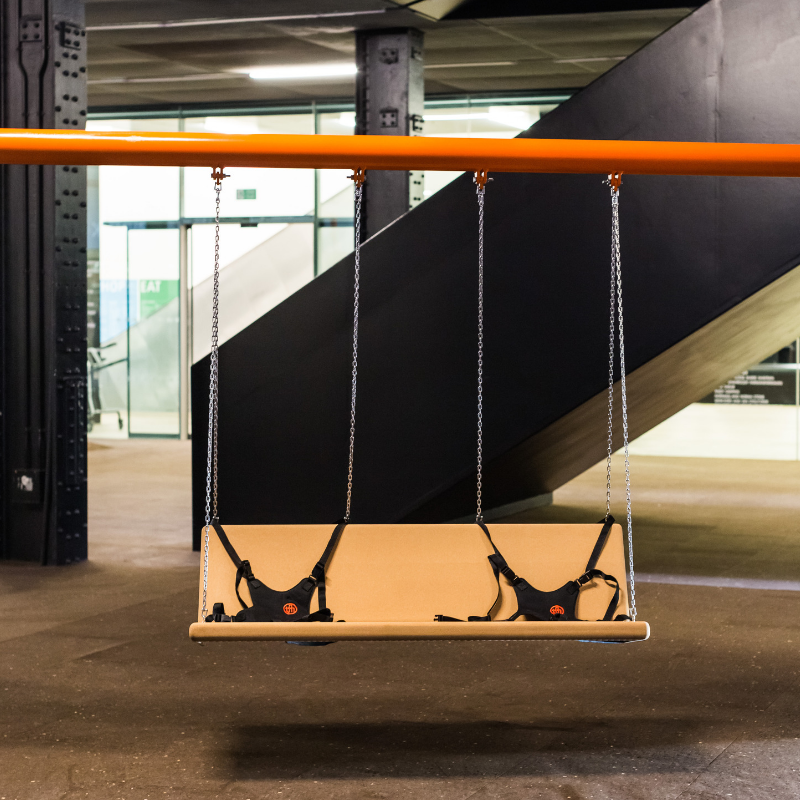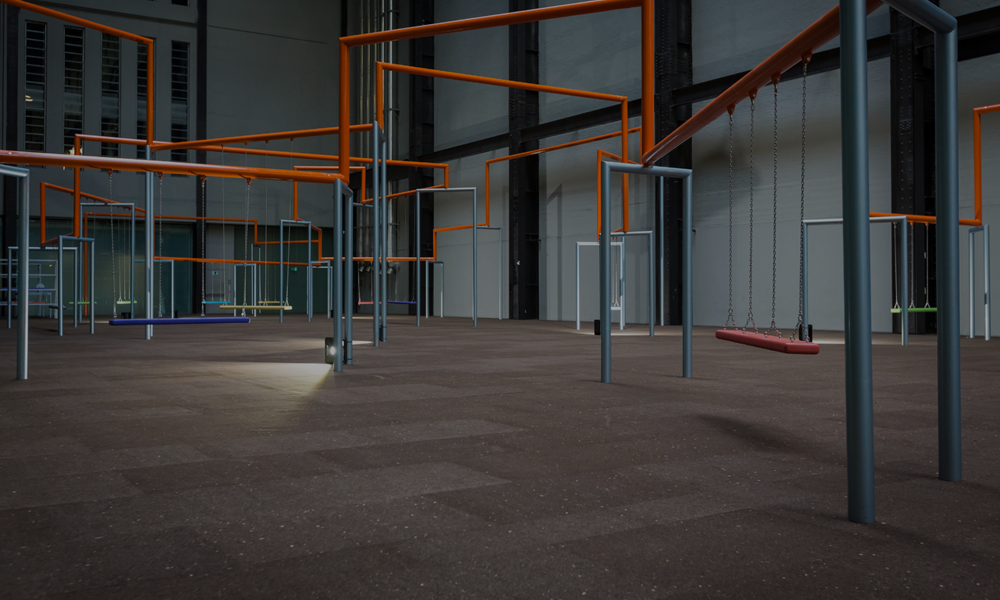Cork is the central element in the installation by the Danish collective SUPERFLEX
Cork is the central element in the installation by the Danish collective SUPERFLEX
London, Copenhagen and Bonn are the three venues of this installation, for which a new cork composite has been developed.
Amorim Cork Composites has developed an innovative cork composite specifically for the One Two Three Swing! Installation, designed by the Danish collective, SUPERFLEX. Originally created for the Tate Modern in London, the work has been replicated in other venues, including Bonn and Copenhagen in 2018.
“Cork plays a key role here, serving as an elastic floor. When we have swings, we need a smooth floor (...) Above all, cork is an organic and non-synthetic material. It serves a purpose and a function. At the same time, it's soft.”
From October 2017 to April 2018, there were approximately 15,000 visitors per day to the Turbine Hall - Tate Modern’s iconic space for large-scale projects. They had the chance to walk on a huge cork installation, measuring about 5000 m2, as an integral part of the One Two Three Swing! Installation created by SUPERFLEX, in the framework of the 3rd edition of the Hyundai Commission.
-
Forest of swings
Known for their highly humorous works, the artists created a huge "forest" of swings and invited visitors to use them individually or in a group. In addition to the cork floor, which ensures soft landings, while also creating an organic and sensory environment, the swivel seats are also made of cork.
Choice of cork for the One Two Three Swing! installation was influenced and mediated by KWY, a multidisciplinary research platform that involves architects, curators and creatives which aims to conceive and support the development and implementation of projects.

“One of the first challenges of this project was to identify a surface that would comply with the safety characteristics required of play structures, and yet not make the artwork feel like a traditional playground. As Portuguese architects, we naturally thought of cork and reached out to Amorim. After months of collaboration, development and testing, we arrived at a solution which passed all safety regulations and provided us with a continuous, natural flooring surface. It was very satisfying to see this beautiful material featured in such a successful way.”
Turbine Hall’s floor was made using a cork composite that combines natural and expanded granules on the surface. After several tests using various materials, cork was the only natural material able to respond positively to the project’s stringent requirements.

Turbine Hall’s floor was made using a cork composite that combines natural and expanded granules on the surface. After several tests using various materials, cork was the only natural material able to respond positively to the project’s stringent requirements.
-
Resistance to wear and tear
On the one hand, the selected material needed to guarantee high resistance to wear and tear, since thousands of people visit the exhibitions in Turbine Hall. During the 3rd edition of the Hyundai Commission, One Two Three Swing! received a total of 2.7 million visitors during the exhibition’s 6-month duration, corresponding to over 100,000 people per week and about 15,000 visitors per day.
-
Shock Absorption
On the other hand, in the case of equipment that visitors can interact with, freely using the swings, it was necessary to prepare the floor for the absorption of high impacts in the event of falls. For this purpose, expanded cork was applied in the impact zones, providing cushioning for falls from heights of 2-3 metres and thereby guaranteeing the safety of users even in the event of an accident.
-
Stability and resistance
In addition to the aforementioned characteristics, the new cork composite was also designed to guarantee dimensional stability and resistance to water and sunshine, since, in addition to covering Turbine Hall’s entire floor area, cork was also applied on the museum’s exterior. Cork has even more prominence in Bonn, given that the installation is presented entirely outside the Bundeskunsthalle museum.
-
Safety guarantee
Cork was also used in the swivel seats, one of the most striking elements of the exhibition concept presented by SUPERFLEX. Agglomerated cork blocks were used for this purpose, which was then painted. The main objectives were to guarantee load capacity (i.e. support the users’ weight), and above all ensure safety in the event of the impact.
The various tests made it possible to ensure that in the event that a loose swing, at maximum height, hits a child in the head, it would have sufficient energy absorption capacity to avoid acceleration of the brain mass, and thereby prevent any intracranial hemorrhage.
From London to Bonn and Copenhagen
Following its success at the Tate Museum in London, UK, Superflex has adapted the installation to the Copenhagen Contemporary, in Denmark, and the Bundeskunsthalle | Playground Project, in Bonn, Germany.

From London to Bonn and Copenhagen
Following its success at the Tate Museum in London, UK, Superflex has adapted the installation to the Copenhagen Contemporary, in Denmark, and the Bundeskunsthalle | Playground Project, in Bonn, Germany.
SUPERFLEX’s installation also enjoyed a highly positive reception from the press, with around 70 published articles and four-star ratings in the newspapers, The Times and The Evening Standard. In view of all the marketing initiatives conducted, the London museum estimated that close to 21.8 million people were reached.
“The motivation of the company's R & D teams and the know-how associated to the material were decisive in ensuring a prompt response to development of a new typology of cork. (...) After the Serpentine Gallery Pavilion and the Victoria & Albert Museum, we’re extremely proud to see that cork is once again used as a key material in a major cultural event in the UK, this time in the Tate Modern.”
The Amorim group's participation in the project was also widely reported In Portugal.
Following the success at the Tate Modern, the installation may be visited at the Bundeskunsthalle in Bonn, Germany, in the framework of the Playground Project, until 28 October 2018; as well as in the Copenhagen Contemporary, the Danish capital’s centre of contemporary art, until December 30, 2018.
Throughout the various stages of the project, Amorim Cork Composites worked closely with the group of artists to build and improve the initial cork composite, based on the information and knowledge acquired.
SUPERFLEX

The Danish collective SUPERFLEX was set up in 1993 in Copenhagen by Jakob Fenger, Bjornstjerne Christiansen and Rasmus Nielsen. The group is internationally recognized for its interest in urban spaces and the way in which it uses art to question contemporary society and culture. The collective’s work has been exhibited in several museums around the world.
News
Tate Modern embraces cork
Visitors to the "Hyundai Commission: SUPERFLEX: One Two Three Swing!" are now able to walk along a colossal cork installation, presented in the Tate Modern - one of the world's most respected contemporary art institutions.